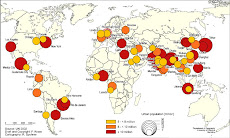Editors
Friday, January 2, 2009
Megacites are unique but not due to size according to Manuel Castells
According to Spanish urban sociologist Manuel Castells, these true megacities are the harbingers of a new form of human society that will spread its influence all over the world in the 21st century. In his view, their sheer numerical size, while awesome, does not represent their true importance. Rather, the megacities’ power lies in the fact that they signify “the nodes of the global economy, concentrating the directional, productive, and managerial functions all over the planet; the control of the media, the real politics of power, and the symbolic capacity to create and diffuse messages. . . . Megacities cannot only be seen in terms of their size, but as a function of their gravitational power towards major regions of the world.”To Castells, it is in Asia that the phenomenon of the megacity can be seen at its most advanced stage. With the handover of Hong Kong to China, for example, a new megacity with a potential population of between 40 and 50 million people is poised to become the economic and commercial centre of the Asia-Pacific Rim. This is the as-yet-unnamed conglomeration of urban centres that includes the ports of Hong Kong and Macao, and the rapidly expanding Chinese industrial centres of Guangzhou, Huizhou, and Zhaoqing. On the basis of extensive research he has conducted in this region, Castells predicts that “this Southern China Metropolis, only vaguely perceived in most of the world at this time, is likely to become the most representative urban face of the 21st century.”Castells believes these enormous urban centres will exercise vast economic, social, political, and cultural influence over both their own countries and the world as a whole, On the leading edge of the information revolution that is transforming the globe, such places will be the beneficiaries of the economic growth fuelled by the rise of the knowledge-based industries of computers and telecommunications. But for those who find themselves left out of this revolution, life in the megacities may be harsh and unpleasant. This is because another defining characteristic of the next millennium’s megacities is the fact that while they are globally connected to the world economy, they are locally disconnected, or split along economic lines, with luxury high-rise commercial and residential districts located cheek-by-jowl beside festering inner-city slums.
Subscribe to:
Posts (Atom)



